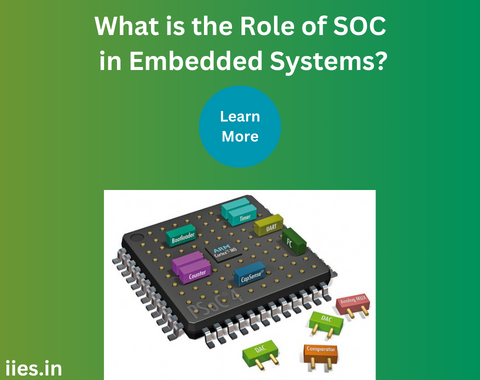
Embedded systems, the silent powerhouses that drive a plethora of modern devices, have witnessed a remarkable transformation with the advent of System-on-Chip (SoC) technology.
SoC represents a paradigm shift in the design and implementation of embedded systems, consolidating multiple functionalities onto a single chip.
This article delves into the significance of SoC in the realm of embedded systems, exploring its evolution, key features, and the profound impact it has had on various industries.
The concept of integrating multiple components onto a single chip dates back to the early days of computing, with developments such as microprocessors and microcontrollers. However, it was the relentless demand for smaller, more efficient, and cost-effective solutions that spurred the evolution of SoC in embedded systems.
Traditional embedded systems involved separate chips for the central processing unit (CPU), memory, input/output (I/O) interfaces, and other components. The integration of these disparate elements into a cohesive SoC marked a revolutionary leap forward. This consolidation not only streamlined the design process but also led to more compact, energy-efficient, and high-performance embedded systems.
1. Integration of Components:
SoC combines diverse components, including the CPU, memory, graphics processing unit (GPU), communication interfaces, and specialized accelerators, onto a single chip. This integration minimizes the physical footprint, reduces power consumption, and enhances overall system efficiency.
2. Customization and Configurability:
SoC designs are highly flexible, allowing manufacturers to tailor the system to specific application requirements. This configurability is especially crucial in diverse industries, ranging from consumer electronics to automotive and industrial automation.
3. Power Efficiency:
By optimizing the architecture and reducing the need for inter-chip communication, SoC designs contribute significantly to power efficiency. This is particularly vital in battery-powered devices, where every milliwatt matters.
4. High Performance:
SoC architectures are designed for high performance, often incorporating advanced processing cores and dedicated hardware accelerators. This ensures that embedded systems can handle demanding tasks, such as real-time data processing and complex computations.
5. Cost Reduction:
The integration of multiple components into a single chip results in a more cost-effective solution. This is especially pertinent in mass-produced devices, where economies of scale play a crucial role in determining the market viability of a product.
1. Consumer Electronics:
SoC technology has revolutionized the consumer electronics landscape, enabling the development of smartphones, smart TVs, and wearable devices with compact form factors and powerful capabilities. The seamless integration of processors, memory, and communication interfaces has become a hallmark of modern gadgets.
2. Automotive:
In the automotive industry, SoC plays a pivotal role in enhancing the performance and functionality of embedded systems. Advanced driver assistance systems (ADAS), in-vehicle infotainment (IVI) systems, and autonomous driving technologies leverage SoC to process large volumes of data in real-time, ensuring a safer and more enjoyable driving experience.
3. Industrial Automation:
Industrial embedded systems benefit from SoC’s ability to handle complex control algorithms, sensor data processing, and communication protocols. This has led to more efficient and intelligent manufacturing processes, with SoC-powered devices facilitating the implementation of Industry 4.0 principles.
4. Healthcare:
In healthcare, SoC has contributed to the development of innovative medical devices, wearable health monitors, and diagnostic tools. The integration of sensors, communication modules, and processing capabilities into a compact form factor enables remote patient monitoring and personalized healthcare solutions.
5. Internet of Things (IoT):
The SoC architecture is well-suited for the diverse requirements of IoT devices. Its compact design, low power consumption, and customizable features make SoC an ideal choice for the myriad connected devices that form the IoT ecosystem, from smart home devices to industrial sensors.
While SoC has undeniably transformed the embedded systems landscape, it is not without challenges. The complexity of designing and verifying integrated circuits, ensuring compatibility between different components, and addressing security concerns are ongoing considerations for SoC developers.
Looking ahead, future trends in SoC for embedded systems include the integration of artificial intelligence (AI) accelerators, increased emphasis on security features,
Challenges and Innovations in SoC for Embedded Systems:
Despite its numerous advantages, the development of SoC for embedded systems comes with its own set of challenges. One primary challenge is the complexity associated with designing and verifying integrated circuits. As SoC integrates multiple components into a single chip, ensuring the seamless interaction and compatibility of these elements is a non-trivial task. This complexity extends to the verification process, where designers must confirm that the integrated components function correctly together.
Security is another critical concern. With the increasing connectivity of embedded systems, the risk of cyber threats and unauthorized access grows. SoC designers must implement robust security measures to safeguard sensitive data and prevent potential breaches. This includes secure boot mechanisms, hardware-based encryption, and protection against side-channel attacks.
In response to these challenges, ongoing innovations in SoC technology are pushing the boundaries of what is possible in embedded systems. One notable trend is the integration of specialized hardware accelerators for artificial intelligence (AI) and machine learning (ML) tasks. This allows embedded systems to efficiently handle AI workloads, opening up new possibilities in areas like computer vision, natural language processing, and predictive analytics.
Future Trends and Innovations: Looking ahead, the future of SoC in embedded systems is marked by several exciting trends and innovations.
The evolution of System-on-Chip technology has propelled embedded systems into a new era of efficiency, performance, and versatility. From powering everyday consumer devices to enabling breakthroughs in automotive safety and healthcare, SoC has become the backbone of modern technology. As the demand for smaller, smarter, and more interconnected devices continues to grow, SoC will undoubtedly play a central role in shaping the future of embedded systems.
Indian Institute of Embedded Systems – IIES